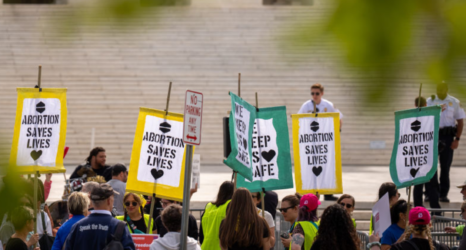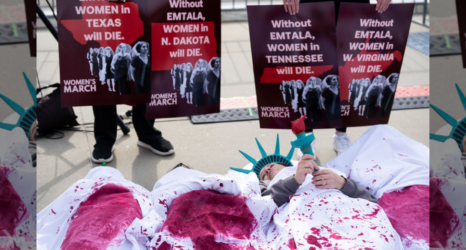On the heels of oral arguments in June Medical Services v. Russo—a Supreme Court case that many fear may signal the beginning of the end of Roe v. Wade—comes a new video geared toward young people that talks honestly and openly about abortion.
Released in late February, AMAZE’s video, “What Is An Abortion?,” covers types of abortions, where to get them and the contemporary political discourse about them.
Most importantly, the video emphasizes that the decision to carry a baby to term or get an abortion is just that: a choice.
The animation uses Sam—a child-friendly purple character narrating the lesson—to keep the audience engaged with fun colors and illustrations, without infantilizing the subject.
AMAZE is a digital media company focused on honestly teaching children and adolescents about sex education—as well as guiding adults when they start teaching young people about sex. Most of AMAZE’s content addresses topics for tweens, including puberty, STDs and personal relationships, and all of their resources are available online for free.
Upon the release of this video, Ms. sat down for an exclusive interview with Tracie Q. Gilbert, Ph.D., of Answer, a co-founder of AMAZE.org.
Below, Gilbert breaks down the motivation behind the video and the need for open, honest, shame-free communication on the topic of abortion.
Ms.: Why is the inclusion of abortion in sex ed curriculum long overdue?
Tracie Q. Gilbert: Abortion is a health practice like any other—one that affects at least one in four individuals with a uterus at some point in their lives. This means that many young people either know someone who’s had an abortion or will chose to have one themselves. Having accurate knowledge about abortion can prove useful in helping young people avoid unnecessary fear about the procedure, and to successfully advocate for themselves and their health care choices.
Why does every young person deserve access to both honest information and reproductive care?
TQG: Every young person, at some point, will need to make decisions about their sexual and reproductive health—whether it’s determining a choice of birth control, beginning a gender-affirming hormone regimen, getting screenings for HPV and breast cancer, or pursuing treatment for fibroids or poly-cystic ovarian syndrome. Getting honest information early on teaches them to be mindful of their sexual health in general and empowers them to make sound authentic choices about their bodies and what they might need more specifically.
Just like other age-appropriate medical services a young person might need, high-quality reproductive care is a right, as it makes sure that young people’s needs are fulfilled in ALL the ways they deserve. Most important, having high-quality reproductive care as a young person sets up a strong precedent for the kinds of care practices they’ll cultivate as adults.
What kind of obstacles does requiring parental consent for an abortion create?
TQG: If parents are affirming their children’s sexual health and genuinely care about their child’s well-being and safety, parental involvement before an abortion can ensure parents remain an active and supportive part of the process.
Unfortunately, some young people find themselves in situations where their parents are abusive, neglectful, highly restrictive or sex-negative in ways that are harmful to a young person in the face of an unplanned pregnancy.
In those cases, requiring parental consent prior to an abortion sets up additional hurdles that could unfairly endanger a young person, or unnecessarily prolong the process, adding to what is already a likely stressful time.
Why are crisis pregnancy centers so dangerous?
TQG: When a young person experiences an unintended pregnancy, the last thing they need is someone attempting to trick or coerce them into believing they cannot make informed decisions about their sexual health.
Far too often, however, crisis pregnancy centers do just that, incorporating false information about abortion and its effects on the body into counseling sessions, and using emotional manipulation to guilt people into making choices that may not truly want to make.
The goal of good sex education is to empower young people to feel confident in making choices that best fit their needs and plans.
On the other hand, crisis pregnancy centers often work in the opposite way, taking away the individual’s right to trust themselves and their own decision-making process.
How can parents begin to tackle this topic with their children?
TQG: Addressing abortion with children begins long before an unintended pregnancy happens. Ideally, it falls into a normal trajectory of developmentally appropriate conversation about sexuality and sexual health, occurring over the life-span.
Bringing up abortion as a topic before it needs to be considered can be a useful way to normalize pregnancy loss, maintain parents as the first line of support and let young people know that they won’t be shamed or stigmatized if an unintended pregnancy occurs.
There are many different ways abortion can be discussed. Discussing local abortion laws or depictions of pregnancy in popular media are great ways to open up a dialogue, and move into a natural place to share personal values. That said, while sharing values is useful and encouraged, parents should be careful not to share in a way that applies undue pressure or projection onto a young person. Be sure they know that no matter what they decide, their developing autonomy and decision-making ability is still valued and trusted.





